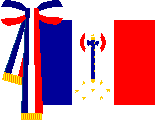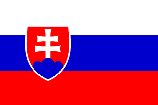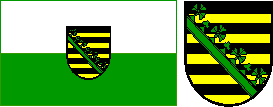- CRANCELIN
- See ‘crown of rue’.
- CRAVAT
- 1)A decorative scarf, usually in national or livery colours and often richly decorated,
generally tied with a bow to the staff below the finial, normally (but by no means exclusively)
used with military flags and sometimes displayed with a cockade (see also
‘cockade 1)’,
‘draping’,
‘finial’,
‘livery colours’,
‘national colours 2)’ and
‘staff 2)’).
- 2) Long black ribbons tied to the staff of a military colour below the finial
to signify mourning by the regiment or unit concerned for the loss of members
of that regiment, or when participating in a military or state funeral - but see
‘draping’.

Presidential Standard, France 1940 – 1943 (fotw & CS)
Please note that in French military usage, and possibly
in others, the cravat is employed (including use with car flags) to differentiate
between ranks and functions.
- CRENELLED
- See ‘embattled’.
- CRESCENT
- 1) In vexillology, a charge in the shape of a crescent moon formed by two interlinked
circles of varying size, generally (but not invariably) shown with the open horns towards
the fly. The crescent is often (but by no means invariably) considered to be symbolic of Islam.
- 2) In heraldry a charge in the form of a crescent moon whose horns unless otherwise
specified point upwards – but see ‘moon 2)’ with following note,
and the note below.


From left: Arms (CS); The National Flag of Turkey (fotw); National Flag of The
Maldives (fotw)
Please note with regard to 2) that a crescent whose horns point
downward may be termed inverted or reversed – see ‘reversed 2)’.
- CREST
- 1) The heraldic term for a symbol that is usually (but not invariably)
attached to the helm, is almost always set above a torse and generally
ensigned over the shield (see also ‘Appendix IV’,
‘armorial bearings’,
‘coat of arms’,
‘ensigned’,
‘helm’,
‘shield’ and
‘wreath 2)’).
- 2) See ‘ship’s crest’.
- 3) See ‘military crest’.
Please note that the term crest should only be used
as specifically defined herein, and should not be considered as a synonym for a coat of arms or set
of armorial bearings (see also
‘armorial bearings’ and
‘coat of arms’).
- CREW’S MEAL PENNANT
- See ‘meal pennant’.
- CROOKED CROSS
- See ‘swastika’.
- CROSS
- 1) Two stripes or bands of equal width (and in the same colour) but of unequal
length, that extend to the outer edges of the shield, flag, canton or panel they
occupy, and intersect at right angles in the exact centre of that flag, canton
or panel – a St George-type cross, a cross fixed, cross throughout, an upright centred,
centred, regular or square cross (see also
‘St George’s Cross’).
- 2) A charge, which may or may not reach the outer edges of the shield, flag, canton
or panel it occupies, and which may not have straight edges but which has four segments
meeting at right angles at a central point – but see note below below and
‘appendix VIII’.
- 3) A generic name for two stripes of the same colour (although two/three
colour variants exist see ‘tripartite’ and
‘layered cross’) and any width, crossing
the field of a flag, panel or canton in any manner (see also
‘saltire’).

![[Hajdina, Slovenia]](../images/v/vxt-d104.gif)
![[Asturias, Spain]](../images/v/vxt-d104a.gif)
![[Pisa, Italy]](../images/v/vxt-d104b.gif)
From left: Flag of Cornwall, UK (fotw); Flag of Hajdina, Slovenia (fotw); Flag of Asturias, Spain (fotw);Flag
of Pisa, Italy (fotw)
Please note however, that whilst
several of the types
used on flags are detailed separately herein – the cross throughout as given in
1) above, the Greek cross, the
Celtic cross, the
Scandinavian cross, the
saltire (or diagonal cross),
Cross of Lorraine,
the swastika,
and the Maltese cross – numerous other
variants exist (mostly used in heraldry but which also sometimes appear on flags),
and it is suggested that ’appendix VIII’ and a suitable glossary
or heraldic dictionary be consulted.
- CROSS-CANTONÉE (or CANTONED)
- See ‘appendix VIII’
- CROSS-CLECHÉE
- See ‘appendix VIII’.
- CROSS-COUNTERCHANGED
- See ‘appendix VIII’.
- CROSS-COUPED
- See ‘appendix VIII
- CROSS-FUSILLY
- See ‘cross-clechée’ in ‘appendix VIII’.
- CROSS-LOZENGY
- See ‘cross-clechée’ in ‘appendix VIII’.
- CROSS-VOIDED
- See ‘appendix VIII’.
- CROSS BOTONNY (BOTTONNY or BOTTONÉE)
- See ‘appendix VIII’.
- CROSS BAR (CROSS-BAR or CROSSBAR)
- The transverse rod, from which a flag is suspended, either attached in the centre or
from one end, or hung by cords from a vertical pole or poles (see also
‘banner 2)’, ‘banner 3)’,
‘frame 1)’, ‘frame 2)’,
‘framed flag’,
‘gonfalon’
and ‘vexillum’).
- CROSS CROSSLET
- See ‘appendix VIII’.
- CROSS FITCHY
- See ‘appendix VIII’.
- CROSS FIXED
- See ‘cross 1)’.
- CROSS FLEURY (FLORY, FLORETTY OR FLEURONNY)
- See ‘appendix VIII’.
- CROSS FORMÉE, (FORMÉ or FORMY)
- See ‘cross pattée’ in ‘appendix VIII’.
- CROSS HUMETTY
- See ‘Greek cross 2)’ (also ‘cross couped’ in ‘appendix VIII’).
- CROSS MALTESE
- See ‘Maltese cross’.
- CROSS MOLINE
- See ‘appendix VIII’.
- CROSS OF ANJOU
- See ‘cross of Lorraine’ below.
- CROSS OF CALATRAVA
- A particularly Hispanic form of the cross fleury - an Iberian cross – see
‘cross fleury’ in ‘appendix VIII’.


Flag of Almagro, Spain (fotw); Flag of Malagón, Spain (fotw)
- CROSS OF CALVARY (or CROSS OF CRUCIFIXION)
- See ‘appendix VIII’.
- CROSS OF LORRAINE
- A cross in which two horizontal arms cross the vertical arm, and currently seen on the arms and
alternative national flag of Hungary, the arms and national flag of Slovakia plus the arms and state
flag of Lithuania ¬ a cross patriarchal, patriarchal cross, archiepiscopal cross or cross of Anjou,
a double or double-armed cross or Jagiellonian cross (see also
‘armorial bearings’,
‘cross 2)’,
‘national flag 1)’
‘one-and-a-half armed cross’,
‘orthodox cross’,
papal cross’,
‘two-and-a-half armed cross’ and
‘state flag 1)’).



From left: The Flag of Free France 1940-44; The National Flag of Slovakia; The
State Arms of Hungary (fotw)
Please note that the terms cross of Lorraine, cross of Anjou, cross
patriarchal and archiepiscopal cross are now considered interchangeable, however, in strict usage
the crosses of Lorraine and Anjou (unlike the others) should both have horizontal arms of equal
length. see supplemental note
![[Cross of Lorraine]](../images/v/vxt-d106a.gif)
Cross of Lorraine According to Strict Usage
- CROSS OF ST ANDREW
- See ‘St Andrew’s Cross’
- CROSS OF ST GEORGE
- See ‘St George’s Cross’
- CROSS OF ST JAMES
- See ‘cross of Santiago’ in ‘appendix VIII’.
- CROSS OF ST PATRICK
- See ‘St Patrick’s Cross’
- CROSS OF SANTIAGO
- See ‘appendix VIII’.
- CROSS OF THE ORDER OF THE KNIGHTS OF CHRIST (CROSS OF THE ORDER
OF CHRIST or CROSS OF THE ORDER OF CHRIST’S KNIGHTS)
- A red cross pattée surmounted by a white Greek Cross, being the former symbol of the medieval
Iberian Order of the Knights of Christ (Ordem dos Cavaleiros de Cristo) which now forms the air
force roundel of Portugal, and is often seen on the sub-national flags of both Portugal and Spain
– a Christ’s Knight’s Cross (see also ‘cross pattée’ in ‘appendix VIII’,
‘Greek Cross 2)’,
‘roundel 1)’ and
‘surmounted by’).




Air Force Roundel, Portugal (CS); Flag of Madeira, Portugal (fotw); Flag
and Arms of Terra Chã, Portugal (Antonio Martins)
- CROSS PATRIARCHAL
- See ‘cross of Lorraine’.
- CROSS PATTÉE (PATÉE, PATTY or PATY)
- See ‘appendix VIII’.
- CROSS POTENT (or POTENCE)
- See ‘appendix VIII’.
- CROSS RAGULY
- See ‘raguly’
- CROSS TAU
- See ‘‘appendix VIII’.
- CROSS THROUGHOUT
- See ‘cross 1)’.
- CROSS TREFOIL (or TREFLEE)
- See ‘cross botonny’ in ‘appendix VIII’.
- CROSSTREE
- 1) In largely US usage, a yard if fitted to a flag mast ashore (see also
‘yard’).
- 2) A cross bar attached near the top of an unstayed flagpole for the purpose
of providing additional halyards to the one reeved at the truck (see also
‘reeve’,
'yard' and
'stayed mast').
- CROWN
- A ceremonial headpiece in the shape of a circlet often made of precious metal
and adorned with pearls and gemstones – see note below (also
‘antique crown’,
‘coronet 1)’, ‘coronet 2)’ and
‘ensigned’).
![[collar]](../images/v/vxt-d105.gif)
UK Royal Crown (Martin Grieve)
Please note that on flags a crown with a curved
bar or bars across the top and a cap within generally (but not invariably) signifies
a reigning monarch, however, the actual design will usually be specific
to a given country and considerable variations exist. Please note also that in
heraldry the term crown has a far wider use, and whilst a few of the many types
encountered are described in this dictionary, it is strongly suggested that a
specialist glossary or dictionary of heraldry be consulted for full details.
- CROWNED
- See ‘ensigned’.
- CROWN OF RUE
- The heraldic term for a coronet placed in bend – or diagonally – across rather
than above a shield or quarter – a crancelin (see also ‘bend’ in ‘Appendix
VI’,
‘coronet’, ‘in bend’,
‘quarter’ and
‘shield 1)’)

The Flag and Arms of Saxony, Germany (CS)
- CROWN TRIUMPHAL
- The heraldic term for a closed garland or chaplet, usually composed of laurel
leaves, and based on the ancient Roman triumphal ornament (see also
‘civic crown 2)’,
‘decking’,
‘garland’ and
‘wreath of immortelles’).
![[collar]](../images/v/vxt-d107.gif)
(Parker)
- CRUTCH
- A term for the central point at which the two triangles formed by a swallow-tailed
cut in the fly meet (see also ‘orthogonal’ and
‘swallow-tail(ed)’).
- CUSTOMS FLAG (ENSIGN or PENNANT)
- A flag or ensign, different from the national/state flag or government ensign (or a
variant thereof) or a pennant, which specifically identifies the installations or vessels
of a country’s customs service (see also ‘national flag’,
‘government ensign’ under ‘ensign’,
and ‘state flag’).

From left: Customs Flags/Ensign, Israel; Customs Flag, Japan;
Customs Ensign, Iceland; Customs Flag, US; Customs Pennant, Thailand (fotw)
- CYBERVEXILLOLOGY (or CYBERVEX)
- Vexillological research and/or the publication of vexillological information
using electronic means, particularly the Internet or other electronic delivery
systems.
- CYPHER
- See ‘monogram’.




![[Hajdina, Slovenia]](../images/v/vxt-d104.gif)
![[Asturias, Spain]](../images/v/vxt-d104a.gif)
![[Pisa, Italy]](../images/v/vxt-d104b.gif)









![[collar]](../images/v/vxt-d105.gif)



![[collar]](../images/v/vxt-d107.gif)